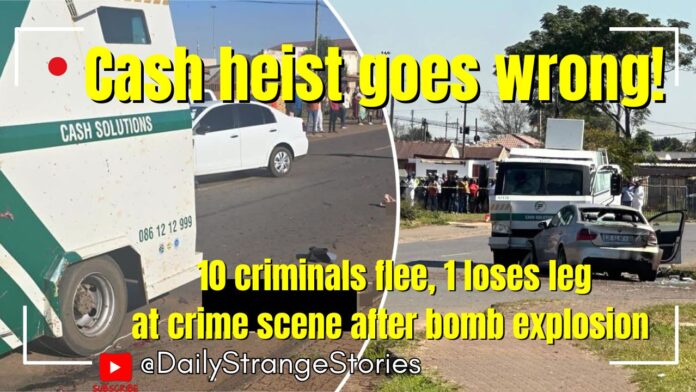In the heart of South Africa, a chilling narrative unfolds, one that speaks to the desperation and brazenness of criminal activity plaguing the nation. This is the story of a cash-in-transit heist gone wrong, a stark reminder of the violent underbelly that simmers beneath the surface of everyday life.
The incident occurred on 5 May in Ekurhuleni, a sprawling municipality east of Johannesburg, an area no stranger to the sounds of sirens and the shadow of crime. On what seemed like an ordinary Tuesday morning, the tranquility of Tokoza, a township within Ekurhuleni, was shattered by the explosive sounds of a heist in progress.

The target, a cash-in-transit van, a vehicle designed to transport money securely, became the epicenter of a meticulously planned but ultimately failed operation. Ten individuals, driven by the lure of quick riches, orchestrated an audacious attempt to seize the van's valuable contents.
According to police reports, the robbers employed a tactic often seen in such heists: ramming the cash van with another vehicle. In this case, a silver BMW was used as the battering ram, a symbol of the cold calculation and disregard for human life that characterizes these crimes.
But this time, something went terribly wrong. As the suspects attempted to breach the armored vehicle, a catastrophic event occurred. It is believed that the robbers tried to blow up the cash van.
The explosion ripped through the scene, leaving behind a trail of destruction and chaos. When the dust settled, it became clear that the heist had backfired in the most gruesome way imaginable. One of the suspects, caught in the heart of the blast, suffered a devastating injury, losing a leg in the process.
Despite the horrific outcome, the remaining members of the gang fled the scene, leaving behind the damaged BMW. They escaped empty-handed, failing to secure any of the cash they had so desperately sought.
The aftermath of the foiled heist painted a grim picture for the authorities who arrived on the scene. Crime scene investigators, clad in white protective suits, meticulously combed the area, documenting the evidence and piecing together the sequence of events. Markers were placed near what appeared to be human remains, a stark reminder of the violence that had unfolded.
The damaged BMW, a key piece of evidence, stood as a silent testament to the failed operation. The driver's side door was open, the rear window shattered, and black stains on the vehicle's rear hinted at the fire damage caused by the explosion.
Images and videos of the bombing quickly spread, offering a chilling glimpse into the reality of cash-in-transit heists in South Africa. A white cord, likely from an explosive device, lay ominously close to what appeared to be a human leg.
While police confirmed that no one died at the scene, the severity of the suspect's injuries raised questions about his chances of survival. The injured suspect was taken along by the other thugs.
The incident in Tokoza is not an isolated one. It is part of a disturbing trend of increasing cash-in-transit robberies in South Africa, a phenomenon that has become a major concern for law enforcement and the public alike.
Just days before the Tokoza heist, another cash-in-transit robbery occurred in Phomolong, Rabie Ridge, also in the Ekurhuleni District. In that incident, a group of eight suspects targeted a cash van, using a Mercedes-Benz to block and overturn the vehicle. Armed with rifles, they stole an undisclosed amount of cash before fleeing the scene in a white Polo and a Fortuner, after setting the Mercedes-Benz alight. Three security officers were injured and taken to the hospital for medical treatment.
On the same day, yet another cash-in-transit robbery was reported in Tsakane, East Rand, followed by another one in Thokoza on May 6, signaling a surge of these organized crime syndicates.
The statistics paint a grim picture. Gauteng, the province that includes Johannesburg and Ekurhuleni, accounts for a significant percentage of the nation's cash-in-transit heists. Johannesburg, in particular, has emerged as a hotspot for these crimes.
In the first two months of 2023 alone, there was a marked increase in cash-in-transit robberies compared to the same period in 2022. These crimes have evolved, with perpetrators employing more sophisticated and violent tactics, including the use of explosives and high-calibre firearms.
The rise in cash-in-transit robberies can be attributed to a number of factors. South Africa faces significant socio-economic challenges, including high levels of poverty, unemployment, and inequality. These conditions create an environment in which some individuals turn to crime as a means of survival.
Organized crime syndicates play a major role in orchestrating these heists. These syndicates are often well-funded and well-equipped, with the resources to plan and execute sophisticated operations. They recruit individuals with specific skills, such as explosives experts and experienced drivers, and operate with a high degree of coordination.
The involvement of former law enforcement officials in these syndicates is also a concern. These individuals bring valuable knowledge of security procedures and law enforcement tactics, making it more difficult for authorities to prevent and investigate these crimes.
The cultural context in South Africa also plays a role. In some communities, there is a perception that the wealthy are unfairly exploiting the poor, leading to a sense of resentment and a willingness to support criminal activity. The glorification of criminals in popular culture can also contribute to the problem.
To combat the rise in cash-in-transit robberies, law enforcement agencies are employing a range of strategies. These include increased patrols in high-risk areas, the use of advanced technology to track and monitor cash vans, and closer cooperation with private security companies.
Community involvement is also seen as crucial. Police are urging members of the public to report any suspicious activity and to provide information that could assist in investigations.
The Cash-In-Transit Association in South Africa (Citasa) plays a key role in coordinating efforts to combat these crimes. Citasa works with law enforcement agencies and private security companies to share information, develop best practices, and advocate for stronger laws and regulations.
However, despite these efforts, cash-in-transit robberies remain a persistent problem in South Africa. The incident in Tokoza serves as a stark reminder of the challenges faced by law enforcement and the need for a multi-faceted approach to address the root causes of crime and violence in the country.
As the investigation into the Tokoza heist continues, the focus is on tracking down the 10 members of the gang and bringing them to justice. The injured suspect, if he survives, and if he gets caught, will also likely face a long prison sentence.
The incident has also sparked a broader debate about the effectiveness of current security measures and the need for more innovative strategies to protect cash-in-transit vehicles. Some have called for the use of more advanced technology, such as drones and facial recognition software, while others have suggested changes to the way cash is transported.
Ultimately, the fight against cash-in-transit robberies in South Africa will require a concerted effort from all stakeholders, including law enforcement agencies, private security companies, communities, and the government. It will also require a commitment to addressing the underlying socio-economic factors that contribute to crime and violence.
Only then can South Africa hope to break the cycle of violence and create a safer and more secure environment for all its citizens.

Follow Us on Twitter









